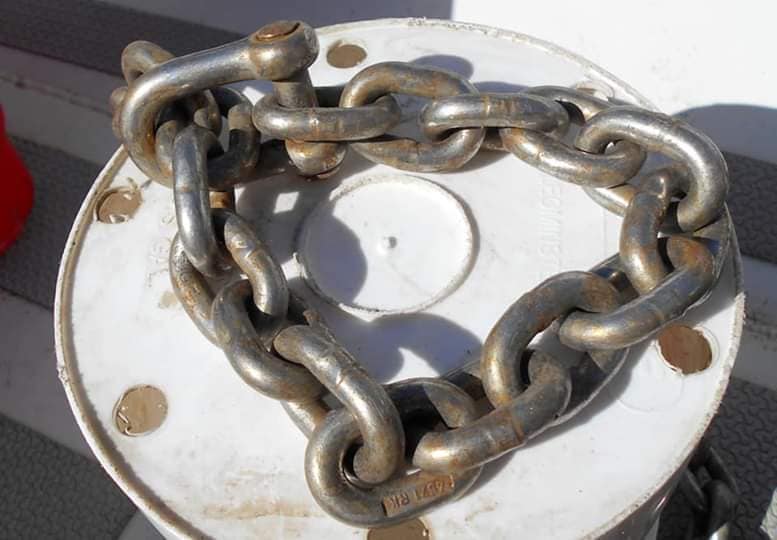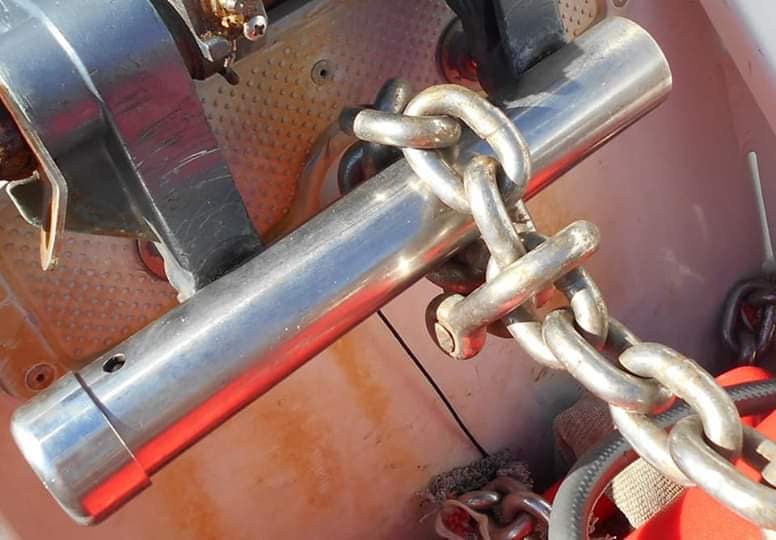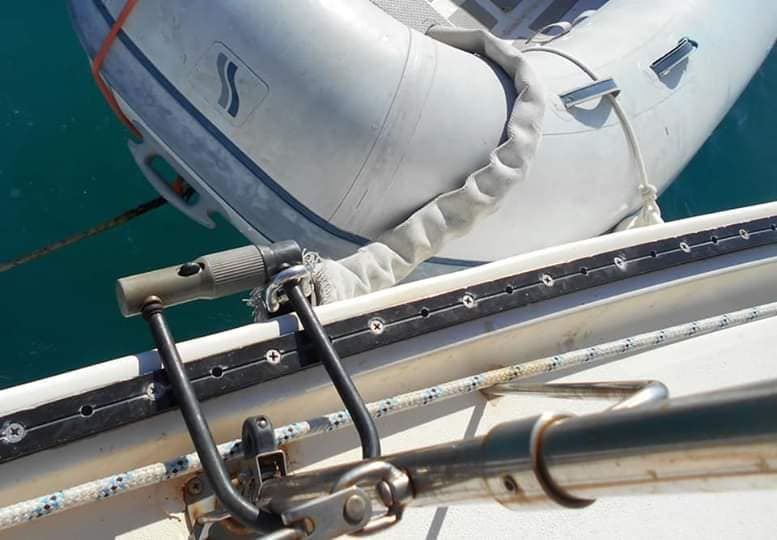Previously published in the Caribbean Compass October 2017 and recently in the Facebook group Caribbean Navigator
by Ken Goodings
Many yachters use steel cables to secure their dinghy to the “mother ship” overnight, or to the dinghy dock when shopping or touring ashore. Security tethers come in every size: from small-gauge vinyl-covered clothesline wire, to motorcycle mega-braid. Light-duty steel cables are easily defeated with bolt cutters or even a coarse-toothed utility knife. (We know of one individual who, having lost his key, simply sat at the dock sawing through his own steel cable with a serrated pocket multi-tool.) The very heaviest gauge braided motor-scooter cables are much too short to be of practical use for securing a dinghy to a dock.
Lynn and I have been cruising in Eastern Caribbean for more than 12 years. To secure our tender, we utilize a 10mm-diameter stainless-steel chain, some six meters in length, which extends forward from the locked outboard motor, through the handle of the fuel tank, then over the dinghy’s bow to the dock or to a stanchion on our yacht. This long chain loops over the bow and into the water. Its catenary weight holds the dinghy away from the dock, allowing boaters to push us out of the way easily to make space for themselves. A fabric anti-chafe sleeve (old fire hose is good for this) protects the Hypalon where the chain crosses over the dinghy’s bow.
When using a security chain, tying the rope dinghy painter to the dock is no longer necessary, freeing up more cleat room for everyone else. High-tensile G4 galvanized chain may be used for this purpose, but we prefer the smooth, clean non-marring properties of stainless steel. Eight-mm stainless chain, although not quite as impressive as the more formidable looking 10mm, will do nicely. Chains smaller than 8mm, in our view, are too easily cut.
The dock end of the chain is secured with a robust, U-shaped high-security bicycle lock with a programmable four-digit combination. We prefer a combination lock, as keys can be lost or forgotten. Our bike lock takes less space on a dock cleat than a rope painter, and the long, 20cm lock hasp can easily fit over a large dock timber if there aren’t any dock cleats at all. Modern U-style keyed bike locks available in the Caribbean now feature sophisticated, double side-ground keys. Our combo bike lock is impressively well made, and we oil it regularly; it’s served us well for nine years.
How can such a large bike lock fit through the end of a chain? We have fastened a heavy stainless shackle onto each end of our dinghy chain. This allows the chain to accommodate the large 12mm-thick hasp of our heavy lock. We’ve chosen the largest stainless-steel shackle whose pin just fits through each end of our chain. After tightly installing the shackle pins in a vice, using permanent thread-locking compound and a large wrench, the flat knobs on the pins were sawed off and the pin ends peened over with a hammer to frustrate any attempt at shackle removal.
Remember, thieves usually only really want your motor, so why not invest in a quality, well thought-out locking device to protect the outboard? The very weakest link in dinghy security can often be the outboard engine padlock. Padlocks are often not as strong as one would hope, and so-called “hardened” hasps have often been proven to be underperformers when attacked with simple tools. In saltwater use, padlocks will quickly rust and jam if not oiled regularly. Simply locking both outboard motor clamp handles together seems optimistic at best, especially if those clamp handles are plastic. We have purchased a heavy-gauge stainless steel tube with a high-security internal key lock inside the end cap. This steel tube completely covers both motor-clamp handles, affording excellent protection against outboard removal — and also becomes the strongest attachment point for the chain on the dinghy.
What about securing the dinghy end of our chain? Since padlocks can be the weakest point of any security tether, we’ve eliminated one lock. That large chain shackle allowed us to form a steel chain slipnoose or loop at one end, which then fits over the outboard motor’s steel locking cylinder. No padlock required!
Multi-strand, braided steel cables are often touted by those who have them as tougher to cut than chain, but we’re still confident that a 10-mm stainless chain is a great way to help keep our dinghy and outboard motor safe. We once met a new cruiser who had a thin security cable on his shiny new Yamaha 15. He said, “I don’t need chain; cable is good enough. Besides, have you ever had your outboard stolen?”
“No,” I smiled back, while pointing at our heavy chain! There are always exceptions of course, but it’s our view that most casual, opportunistic dinghy thieves rarely carry sophisticated tools such as hydraulic bolt cutters, angle grinders, cryogenic spray or sledgehammers. A friend bought some 8mm stainless steel dinghy security chain in Guadeloupe this season. We watched intently while the sturdy young chandlery employee struggled to cut the chain with a 120cm long-handled bolt cutter. He cut each half of one link, taking three tries on each side, virtually falling to the concrete floor. Tough stuff indeed! Planning to cut a 10mm stainless chain quickly and stealthily with a machete or standard hardware store bolt cutter? Good luck with that!
We’ve now tethered our outboard’s fuel hose as well; someone twice tried to steal that, too! For the same reason, our dinghy is empty. No hand-operated bilge pumps, tube repair kits, air pumps, flashlights, sandals, or portable running lights; just a scoop bailer, heaving line and bug repellant. Young kids often like to climb in and out of beached or docked dinghies to play. Loose gear walks away!
We know that our integrated chain security system has already saved our dinghy from theft multiple times in the past twelve years of full-time cruising. Every sailor knows that replacing a stolen dinghy costs much more than time, money, and inconvenience, especially when you’re anchored out. Dinghy’s gone walkabout? How will you get to shore?
Our continuing motto is “Don’t be the low hanging fruit!”
We bought our used stainless chain from another sailor. Use a large, omega shaped ss shackle on the end. Use Loctite in the shackle threads, cut off the knob and hammer both ends of the pin flat. That shackle, one size larger than the chain, will never come off! Make a slip noose as shown for the outboard end of the chain. For 8mm chain use a 10mm shackle. For 10mm chain use a 12mm shackle. No padlock is required at the motor. Note, it takes me 200 strokes with a brand-new hacksaw blade, times two, to cut tough 8mm stainless chain while it’s held securely in a steel bench vice on the dock. 10mm chain takes even longer.
Why not use galvanized anchor chain? Galvanized chain makes a mess in the dinghy and is more easily cut with shears or a hacksaw than the tougher, cleaner stainless chain.
At the other of the ss chain, install a second large ss shackle so that you can use a seriously bigger lock.
Regular padlocks are a weak link, rusty, and defeatable. Go big or go home!
A Note From Boatwatch:
In the event your dinghy does go missing please file a report with the Caribbean Safety and Security Net (CSSN).
The Caribbean Safety and Security Net’s (CSSN) primary mission is the collection and dissemination of accurate information relating to crimes against yachts in the Caribbean, enabling cruisers to make intelligent decisions about how and where they cruise.
This is accomplished through the resources and information available on this website, Facebook, Twitter and RSS feed. The CSSN website includes all of the current and historic information on reported incidents (use the Island Reports button to search for/sort the database) Also you can see all posts, (see News & Reports) information and links to a variety of other resources related to safety and security for cruisers (check out the menu at the TOP). Take a few minutes and explore our site.
“Know Before You Go!”




